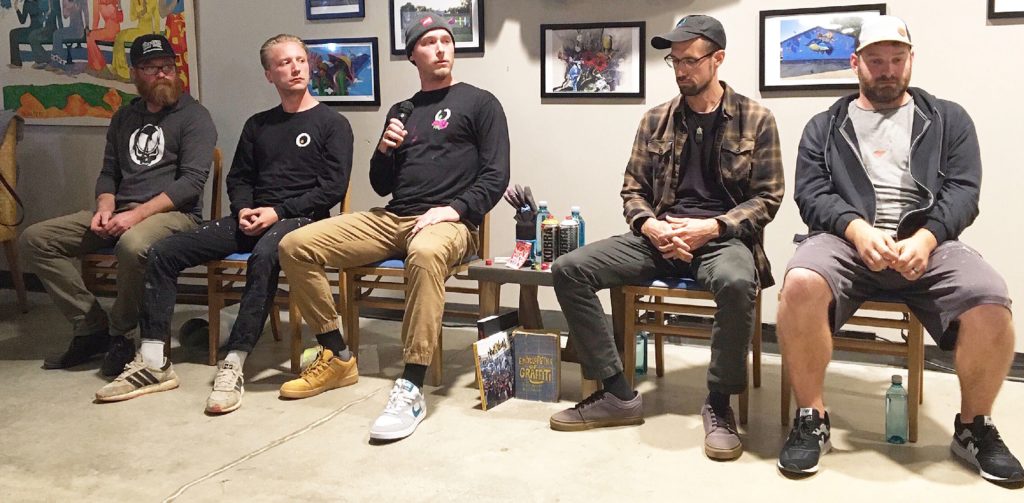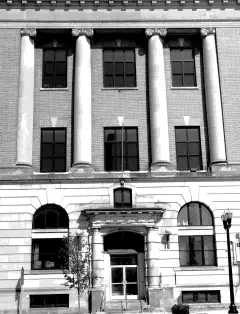By Patsy Isenberg
Assessing public art such as the dozens of murals that have sprung up in Flint over the past year, one of the artists involved in the Flint Public Art Project (FPAP) said Friday street art is “a vehicle for social change.”
“This whole program proves that you can lift yourself up– people will come around and give you support and the sky’s the limit … the places that need it bring out the best experience,” according to Jerrod Tobias, a muralist from Ft. Wayne, Indiana.
Tobias was one of five artists involved in the Flint mural project brought together for a wide-ranging discussion on public art Friday night at Totem Books. The event was part of the weeklong Free City Mural Festival celebrating the recent creation of more than 80 murals in the city.
The audience of about 70 included artists, other muralists, community activists, Totem regulars, and others.
Lori Yost from Totem Books introduced owners, Dean and Linda Yeotis, the staff of Totem, and partners Phillip Barnhart and Joe Schipani, executive director of the Flint Public Art Project, She also acknowledged the UM-Flint Office of University Outreach’s Truth and Action Partnership Project, funded by the W.K. Kellogg Foundation, which sponsored the event.
Many of the muralists have adopted customized names and often don’t use their last names. On the panel were:
–Tobias from Tobias Studios in Ft. Wayne, Indiana,
–Often Seen Rarely Spoken (OSRS) members Jeremy, a “transitioning graffiti writer and mural artist” from Louisville, Kentucky, and Ian, the “behind the scenes finance guy” from Cincinnati, Ohio.
–J Muzacz, from Austin, Texas, a public artist for 16 years, also an art educator and creator of mosaic installations.
–Kevin Burdick, a Flint artist who goes by “Scraps.” He said he’s been spraying paint for over 15 years. He runs a company called Scraps Designs.
The panel was moderated by Kady Yellow, an artist herself who came to Flint in August and who also moderated last Wednesday’s reception at the Community Foundation of Greater Flint (CFGF) covered in EVM’s online edition.

Muralists on FPAP panel at Totem Books during Free City Mural Festival (from left) Jerrod Tobias, Jeremy and Ian of OSRS, J Muzacz, Kevin “Scraps” Burdick (Photo by Patsy Isenberg)
Making it full-time work isn’t easy
Yellow said she hunted for “full time street artists” for the panel, “not folks who come home after a long day of work” somewhere else but who are working all day long to paint the streets” to bring public art to the community.
Yellow said she wanted to ask about “the nitty gritty stuff” and encouraged the audience to do the same. First she asked the panel to talk about “the transition of going from pedestrian life to road life” — how they came to decide to leave traditional jobs and become traveling street artists.
Ian, from OSRS, said he focuses on communication and cold calling to keep the business going since this is the duo’s fulltime work; they have been traveling street artists for years. He said he was in St. Petersburg, Florida checking out murals and through someone there was put in touch with the Flint Public Art Project and Joe Schipani. That’s how OSRS ended up in Flint.
Jeremy, also from OSRS, said, “We came from graffiti and we painted graffiti for maybe ten years before the murals and that put us in a mindset of traveling around a lot and just putting the work in to go to these other cities and go to these gritty places and leave our marks.” He said the two ” transferred that work ethic to go into run down parts of town.”
“We like to paint at night, we like being under train trestles and bridges, kinda those darker places,” he said.
Ian added that because he and Jeremy both came from business backgrounds, especially Ian who had been in sales, they began to realize the income potential and see that perhaps they could make this their careers.
A “common hunger”
Tobias said crowdfunding had recently been successful but before that he had networked with people through the “Occupy” movement which put them in touch with people they could relate to, a network, he said, of “ leftists, activists, radicals, mentally ill, homeless, substance abuse, the whole scene pretty much.
“We all got this common sort of hunger to kind of take the bull by the horns … rather than looking to our leaders” for work, he said.
They spray painted all over town and used that for their business card and started a non-profit gallery. This led to someone from a parks and recreation office offering a job painting a 300-foot-long mural. It took three years to complete and earned him and his wife $65,000 from the City of Ft. Wayne.
That changed the game for them. Now they reach out to community organizations, grants and other opportunities available to them and disenfranchised people they have met.
J Muzacz, who teaches as well as doing public art, compared working in a studio to painting on the street. He said he prefers sharing his art with the public rather than a single person who will hang his art on a wall.
“We’re all trying to impress each other”
Yellow asked Kevin Burdick, the only Flint artist on the panel, how he feels about the Flint Art Project enabling him to “just get up and walk out his door” and not have to travel to meet world class artists and learn from them.
“Basically it’s a dream come true,” Burdick said. He said he’s been a “fan boy” for many of the artists who’ve come to Flint. He’s done several of the FPAP murals and worked alongside many of the visiting artists over the past year.
He added his art has improved by being exposed to different styles. He said he feels that if somebody likes his work he’s satisfied, but with all these artists in town lately a competitive spirit has emerged.
“We’re all trying to impress each other” and that is a motivating factor too for all of them.
Kady asked how they handle people reacting to a muralist’s claim of being an artist by saying things like “but really what do you do … what’s your day job?” noting that it’s rare to be an actual full time artist these days and hard for some people to comprehend.
Painting outdoors in Michigan isn’t always easy, it’s pretty seasonal. Burdick says “I’m lucky enough” being in Michigan “that I’ve found a niche … doing automotive art.”
Murals take planning
The panelists talked about their various pre-painting processes, all the thinking and conceptualizing and planning the layers and getting wrapped up in the creativity involved and losing a lot of sleep.
Each artist has developed their own system and several brought samples of their mockups. OSRS brought one to pass around and said they do all their designs on a computer.
Tobias brought a mockup done by hand, for a mural that’s going up in Flint. He explained his process in this example. First there’s the concept done as a line drawing that he thought “would translate and that I could scale up.”
The line drawings are what he shows the client “before putting a whole lot of time in.” He then did a color study using the mural paint he uses at home in Indiana.
There were lots of firsts with this one, he said: the first time he used all spray paint, his first time combining “natural realism” with an “abstract pattern,” and the first time he had “total creative freedom.”
It was also his first out-of-town job. He said he tried to pull all of his tools together on this one because he wanted to “swing for the fences” on it and, as Burdick had said, “I’ve never felt more pressure and had so much freedom.”
Several of them expressed their “intimidation” from knowing they have to climb to the heights they often have to work at. British muralists the Nomad Clan –Joy Gilleard and Hayley Garner– shared stories of multi-story buildings they’ve done, including the tallest mural ever in the United Kingdom–seven stories tall.
Grids, projectors, tracing: techniques described
Asked to comment on whether they use a grid system to transfer their designs to the wall. Some used the old-fashioned grid system, some work it out in Photoshop to see what part of the drawing would land on what part of the wall and notice the relationship of elements in the drawing to other elements.
Another technique is to project the image with a digital projector via a computer and trace that image. Sometimes they lightly draw the image onto the wall which enables the painter to make corrections if necessary.
The muralists’ life–traveling, working with clients
The panel was asked to talk about how many places they’d traveled to for their work. J said that he’s been to six or seven countries and several states. Jeremy said that for murals he’d been to maybe five or six states and has actually done more traveling with graffiti work. “Part of the allure of graffiti is seeing other cities which has sent them “… to Europe a few times, South America twice, probably more than half of the states and pretty much every large scale city in the United States.”
One woman asked them to talk more about developing their concepts for the designs and working that out with clients. Tobias said, “You kind of have to reconcile reality with people a lot of times … there’s this delusion … that (money) grants territorial status.“
“I tell them ‘I have a certain thing that I want to do here and if you don’t want me to do that, then you probably better find somebody else to do it.’ I’m not gonna sacrifice my experience … for a little bit of loot … in the end it’s about creating art.”
In talking about the legalities of street art, the muralists referred mostly to other countries. Jeremy said that some countries who don’t allow it just erase it. He said that a friend of OSRS’s was in jail for four months in Japan. The consensus was that in other countries being jailed for painting murals is not that rare.
J shared a story about a group of graffiti artists painting a wall in Nepal which caused a crowd to gather. The artists were strongly told by police to stop painting. J thought it was not because they cared about the wall being painted but because of the people gathered there posed a threat in a country where freedom is limited. At that time Nepal was a totalitarian dictatorship.
Jeremy described painting a wall in Detroit when the police came by and tried to make them stop. Fortunately the owner of the building was standing right there and vouched for them.
FPAP Executive Director Joe Schipani asked how so much traveling affects their relationships, and Yellow wondered what the divorce rate might be among street artists.
J said his situation has been working out well. “I’m married to a lovely Japanese woman … she believes, like in Japan, that men in their 30s, 40s, and 50s are supposed to bust their ass working, so she’s happy …”
The last question asked was how the artists feel about painting in blighted areas as opposed to cities that are already beautified. The artists agreed that cities like Flint get a better community response and the work is appreciated more. It’s like the “icing on the cake so to speak,” they said.
Asked how they feel about Flint and whether they’d come back, J Muzacz replied and the others chimed in, “absofuckinlutely.”
Banner photo: Jerrod Tobias’s mural on Dover Garage Door building, 2435 S. Grand Traverse (Photo by Patsy Isenberg)
EVM Staff Writer Patsy Isenberg can be reached at pisenber@gmail.com.


You must be logged in to post a comment.